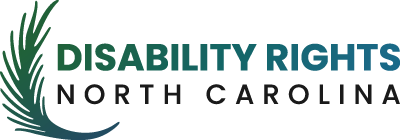Critical importance of media's representation of people with disabilities and disability issues
One in three people in North Carolina have a disability, and one in four nationwide have a disability. Collectively, disabled people are among the largest marginalized groups in NC and in the US, intersecting with race, socio-economic status, age, and gender. That’s why the media’s understanding and reporting on issues that affect disabled people is critical. Simply put, nearly every issue a reporter covers has a disability angle or consideration.
We at DRNC are here to help provide contextualization to your story and provide access to our expert staff about the rights of people with disabilities. You may find it useful to know about the kinds of work we do.
Contact us
If you are a member of the media and want to speak with someone about a story you are working on, email Cas Shearin, at cas.shearin@disabilityrightsnc.org about your request and be sure to include your deadline. She responds to media requests quickly. (Important note: If you are not a member of the media, and you are seeking assistance from DRNC staff about an issue related to your disability, do not email Cas; that will only delay our ability to help you. Please schedule an intake appointment with our office online or call 919-856-2195.)
Resources for reporters
On this page, we also want to share resources you may find helpful in reporting about disability issues and in interviewing disabled people.
Check out this post from Catherine Komp with NC Local about sensitive and accessible reporting, featuring an interview with Hannah Wise. In addition to being a great piece, it’s chockfull of great resources for reporters.
You can read about disability culture from DRNC’s CEO, Virginia Knowlton Marcus.
The Society of Professional Journalists has a section on Covering Disability Issues in its Diversity Toolbox.
National Public Radio (NPR) created this 5-minute video, “Reporting on Disability: Tips from NPR Experts,” in which they cover language, framing, ableism, and accommodations.
The National Center on Disability and Journalism, Walter Cronkite School of Journalism and Mass Communications, Arizona State University has a Disability Language Style Guide. The Ford Foundation is an excellent resource for information about disability prevalence and relevance.
Speaking of The Ford Foundation, check out this video with Rebecca Cokley, who currently serves as the Foundation’s US Disability Rights Program Officer, speaking briefly about disability inclusion. (Note, the national statistic about the number of people with a disability is now 1 in 4.)
The Ford Foundation has a Disability Inclusion Toolkit that is great and includes language/terminology.
Inspiration porn is a trap some reporters fall into. Please don’t do that. Relatedly, check out this TedTalk from Stella Young, I’m not your inspiration, thank you very much. (Ms. Young, an Australian journalist and comedian, died six months after her TedTalk.)
Read about Lawrence Carter-Long’s #JustSayThe Word campaign in an NPR interview.
This lively TedTalk featuring comedian and writer Maysoon Zayid deftly illustrates why understanding disability is critical.
Great short video – without disability there is no DEI.
Branding and Identity Guidelines
The primary version of the logo should be used in most circumstances. It features the full name of Disability Rights North Carolina. The full color versions of the logos, presented here, should only be used on a white background.
Vector
Scalable format for online and print.
PNG
Alternative format that works with most applications.
